Literary rating: ★★★★★
Kick-butt quotient: ☆☆☆☆½
 Independent Goodreads author (and one of my Goodreads friends) P. Pherson Green has been writing since the late 90s, and has previously had short stories published in various venues. However, this novel, the opener for his projected White Sword Saga series, is his long-fiction debut. He graciously gifted me with a hardcover review copy; no guarantee of a favorable review was requested, or given. My wife and I read the book together, during the intermittent and usually short times we were both traveling together in the car; so the nearly two months it took to read is misleading. It would have been a much quicker read if I’d read it by myself, devoting all of my individual reading time to it.
Independent Goodreads author (and one of my Goodreads friends) P. Pherson Green has been writing since the late 90s, and has previously had short stories published in various venues. However, this novel, the opener for his projected White Sword Saga series, is his long-fiction debut. He graciously gifted me with a hardcover review copy; no guarantee of a favorable review was requested, or given. My wife and I read the book together, during the intermittent and usually short times we were both traveling together in the car; so the nearly two months it took to read is misleading. It would have been a much quicker read if I’d read it by myself, devoting all of my individual reading time to it.
This is a work of traditional epic fantasy, set (as most tales in this genre are) in a medieval-like setting resembling the Europe of that day, except in an invented fantasy world. (A helpful map is provided, though it doesn’t show every single locality a reader might like to locate.) It would be fair to say that most if not all English-language epic fantasy written from the last half of the 20th century on owes something to the inescapable influence of Tolkien’s monumental LOTR saga, and this novel is no exception. We have here, ultimately, a quest narrative involving an artifact of great significance (and great seductive power, of an unwholesome sort). The characters’ world is one with a very long history, involving elder races and cataclysmic wars which have consequences for the present. Two non-human races, the Allarie and the Groll, are respectively much like Tolkien’s elves and orcs.
More importantly, we’re very definitely dealing here with a conflict between good and evil, with domination of a world at stake; and the conflict is not simply one of “Us” (the “good” characters) vs. “Them” (the “bad” characters), but rather within “Us” as well, since all humans can be tempted by evil. And like Tolkien (who once famously characterized the LOTR corpus as a “Catholic work”) Green is a Christian author, who writes from a Christian conception of the universe. Neither writer makes any explicit reference to Christianity, and indeed both are dealing with a world in which Christ has not been born; Middle Earth is supposedly our world long before Christianity existed, and Green’s Silver World (he introduces that name only in a short note after the novel proper) is an entirely different world with a different salvation history. But like Tolkien’s Morgoth (“the Great Enemy, of whom Sauron of Mordor was but a servant”) the entity variously known here as the Shadow, the Wyrm, the Foul Pretender or the Dark Beguiler is recognizable as Satan; and the apparently pagan polytheism of the Silver World isn’t quite as polytheistic as it initially seems.
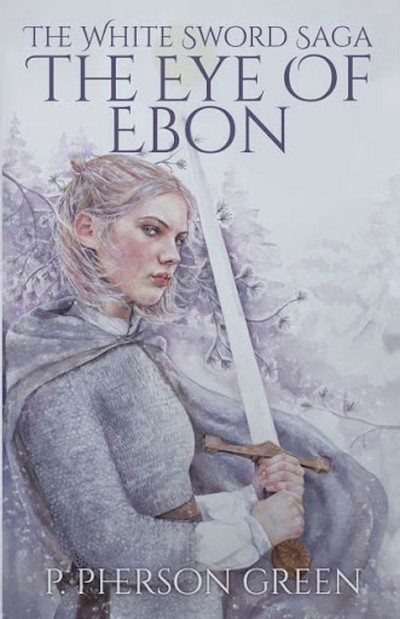 For all that, Green is his own person with his own literary vision and style; The Eye of Ebon is not a direct LOTR knock-off, in the way that Terry Brooks’ The Sword of Shanarra is. A major difference, of course, is the distaff perspective. While Tolkien’s Eowyn is an action-capable female, she’s not the heroine of the saga; his major characters, and most of the characters who display any real agency, or play a direct role in defeating evil, are male. Here, the two viewpoint characters, protagonist Samiare (whom you see depicted on the book’s cover) and essentially co-protagonist Rugette are both female, and formidable fighting females who carry the brunt of the book’s down-and-dirty struggle against evil, and who make the key, crucial gut wrenching and difficult moral decisions at the climactic points. (I was already inclined to rate the book at five stars, but those were the moments that clinched it, and for me moved this tale into the ranks of great, rather than merely good, literature!)
For all that, Green is his own person with his own literary vision and style; The Eye of Ebon is not a direct LOTR knock-off, in the way that Terry Brooks’ The Sword of Shanarra is. A major difference, of course, is the distaff perspective. While Tolkien’s Eowyn is an action-capable female, she’s not the heroine of the saga; his major characters, and most of the characters who display any real agency, or play a direct role in defeating evil, are male. Here, the two viewpoint characters, protagonist Samiare (whom you see depicted on the book’s cover) and essentially co-protagonist Rugette are both female, and formidable fighting females who carry the brunt of the book’s down-and-dirty struggle against evil, and who make the key, crucial gut wrenching and difficult moral decisions at the climactic points. (I was already inclined to rate the book at five stars, but those were the moments that clinched it, and for me moved this tale into the ranks of great, rather than merely good, literature!)
To be sure, unlike Rugette, whose combat skills, especially archery, result from rigorous training since she was in her early teens (I’d guess her to be about 30 here) and have been honed in years spent as a high-ranking warrior and scout fighting the Groll, Samiare, an untrained girl of 15, owes her prowess to a mysterious sword. At the very beginning of the main narrative, she lies dying in the snows of her homeland from cold and blood loss after being gang-raped by a band of Groll and renegade humans, who carved an obscenity on her belly, beat her and tortured her with branding irons, after killing her father and making off with her sister. When she cried out for deliverance “to the one god she knew –the one who watched over,” that sword was gifted to her by a glowing man-like being; and it proves to be no ordinary sword. But she still has to hold it and wield it –and make decisions about how she uses it.
The above paragraph suggests another difference from the Tolkien corpus; this narrative is much grittier, and gorier. While the gang-rape itself isn’t really directly described, we can tell it occurred; and while Green doesn’t make the brutalizing and torture here any more drawn-out than it has to be to make us feel it, he does make us do that. This sets a tone for a very violent book; there’s a lot of mortal combat action with edged weapons, and the Groll are an extremely sadistic and treacherous bunch, even to each other. (Tolkien, in a letter, once characterized the orcs as “almost irremediable,” but allowed that no being created by God is wholly irremediable. We get the impression here that the Groll may be; but even here, Green depicts them as having a claim to merciful treatment when they’re disabled in combat, which I regard as a plus.) So there’s a high body count, with quite a lot of humans and humanoids dying, often in nastily unpleasant ways. There’s no “pornography of violence,” but we do see the spilled entrails, severed limbs, split skulls, etc. However, there’s no quoted bad language, and no explicit sexual content. (In fact, the only reference to sex at all, besides the implied rape above, occupies a tastefully phrased single part of one sentence, in 230 pages of text proper. This would definitely not be characterized as a “romantasy.”)
Green has a serviceable, dignified and assured, naturally flowing prose style that holds interest well. Settings, scenes and people are described vividly enough to be pictured in the reader’s mind (and some of the scenes conjured rival those depicted by Robert E. Howard or A. Merritt for atmosphere and spectacle!), but not over-described. World-building is delivered along the way of the storyline, without info-dumps (there are a couple of roughly page-long appendices, “About the Silver World” and “The Four Lands,” which should be read). There aren’t many serious typos, the worst one being that “reigns” tends to be substituted when “reins” is meant (but that’s a quibble). We come to realize before long that the Prologue describes events taking place millennia before the main story, and occasional interspersed flashbacks set in the same time-frame aren’t distinguished by typeface or a heading; but the reader quickly comes to identify and understand these, and they do convey important information.
There’s no cliff-hanger here; the challenge of the main plot is brought to its conclusion. But it’s clear that the overall epochal struggle of the Four Lands is only beginning, and I’m invested in continuing the series!
Author: P. Pherson Green.
Publisher: Gold Dragon Publishing, available through Amazon, both for Kindle and as a printed book.
A version of this review previously appeared on Goodreads.





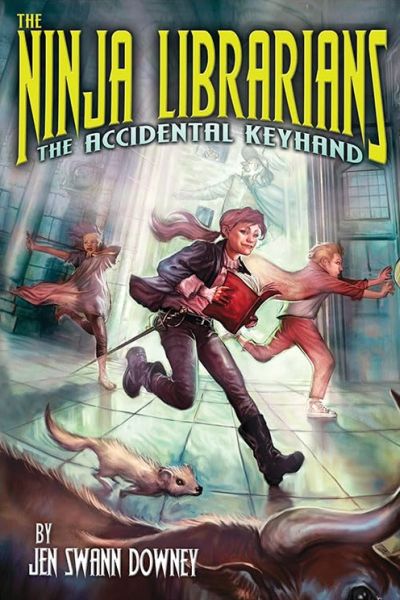 (That quote also answers the question of whether this is fantasy or science fiction; that would depend on whether the author intended us to view the speculative elements as enabled by magic –which, as noted above, she did!– or by natural phenomena/technology unknown to present science.) 12-year-old protagonist Dorothea “Dorrie” Barnes is a library-loving kid growing up in Passaic, New Jersey (I suspect this might be Downey’s hometown, but can’t confirm that), in a chaotic household with her inventor father, college instructor mom, 14-year-old brother Marcus, and three-year-old sister Miranda. (The family shares the house with her great-aunt Alice, who’s an anthropologist.) Dorrie’s a pretty ordinary tween, albeit one with a sense of justice and a liking for the idea of sword-fighting against villains; she’s got a blunt practice sword and takes a library-sponsored fencing and stage combat class. But when the book opens on the day of the library’s annual Pen and Sword Festival (a sort of low-budget Renaissance Faire), a succession of freak events will very soon suck Dorrie and Marcus into a most un-ordinary experience….
(That quote also answers the question of whether this is fantasy or science fiction; that would depend on whether the author intended us to view the speculative elements as enabled by magic –which, as noted above, she did!– or by natural phenomena/technology unknown to present science.) 12-year-old protagonist Dorothea “Dorrie” Barnes is a library-loving kid growing up in Passaic, New Jersey (I suspect this might be Downey’s hometown, but can’t confirm that), in a chaotic household with her inventor father, college instructor mom, 14-year-old brother Marcus, and three-year-old sister Miranda. (The family shares the house with her great-aunt Alice, who’s an anthropologist.) Dorrie’s a pretty ordinary tween, albeit one with a sense of justice and a liking for the idea of sword-fighting against villains; she’s got a blunt practice sword and takes a library-sponsored fencing and stage combat class. But when the book opens on the day of the library’s annual Pen and Sword Festival (a sort of low-budget Renaissance Faire), a succession of freak events will very soon suck Dorrie and Marcus into a most un-ordinary experience…. About a year has elapsed since the events of the previous book. CIA agent Olivia Markham landed on her feet sufficiently, after the events in that one, to preserve her career with the Company; but since then, at her request, she’s been moved to a desk job. For most of the interim, she’s been in charge of an agency safehouse in Montenegro, which fronts as a free clinic for the town’s numerous foreign refugees, run by an NGO that’s not aware of the CIA connection. (The clinic work is real; when she was recruited by the agency in the first book, Olivia was a college pre-med student, and she has EMT certification.) She’s also fallen in love with a French medical doctor at the local hospital; the two are living together, and will get engaged in the first chapter. But …she’s about to cross paths with an Islamic terrorist mastermind from the previous book. Meanwhile, Italian spy Stasia Fiore is still investigating the theft of a Predator drone from the Italian military; and Capt. Beta Czerna is soon to be approached by a desperate woman who needs help in rescuing her sister from the clutches of a Polish crime lord who’s into sex trafficking (among other villainous things). Circumstances are about to converge these plot strands, and bring all three ladies together for a violent, high-stakes thrill ride.
About a year has elapsed since the events of the previous book. CIA agent Olivia Markham landed on her feet sufficiently, after the events in that one, to preserve her career with the Company; but since then, at her request, she’s been moved to a desk job. For most of the interim, she’s been in charge of an agency safehouse in Montenegro, which fronts as a free clinic for the town’s numerous foreign refugees, run by an NGO that’s not aware of the CIA connection. (The clinic work is real; when she was recruited by the agency in the first book, Olivia was a college pre-med student, and she has EMT certification.) She’s also fallen in love with a French medical doctor at the local hospital; the two are living together, and will get engaged in the first chapter. But …she’s about to cross paths with an Islamic terrorist mastermind from the previous book. Meanwhile, Italian spy Stasia Fiore is still investigating the theft of a Predator drone from the Italian military; and Capt. Beta Czerna is soon to be approached by a desperate woman who needs help in rescuing her sister from the clutches of a Polish crime lord who’s into sex trafficking (among other villainous things). Circumstances are about to converge these plot strands, and bring all three ladies together for a violent, high-stakes thrill ride. That trait got her in trouble on her latest mission. It wasn’t supposed to be a hit; she was simply posing as the glamorous mistress of a drug dealer, delivering money for him to a Middle Eastern crime boss. But (as we learn along with her, at the debriefing in the first chapter) her meeting was compromised by an unknown leak in the CIA, who’d tipped the bad guys off as to who she was. They’d decided to test the tip by setting up a situation where she’d have to act to try to rescue a 12-year-old sex trafficking victim, figuring that she could then easily be dealt with, since she’d come unarmed. Unhappily for them, Fortune’s quite adept at improvising a weapon when she has to; though she doesn’t care much for high heels, she dispatched the head honcho with a stiletto heel on the shoes she was wearing, and got away clean, presumably with the 12-year-old. (We learn about this only in a terse second-hand report; I’d have loved to read it in real time!) Now, the deceased’s brother Ahmad, also a big-time crime lord, has put her picture all over the Dark Web, with a million-dollar price on her head (ten million, if she can be delivered to him alive to be tortured).
That trait got her in trouble on her latest mission. It wasn’t supposed to be a hit; she was simply posing as the glamorous mistress of a drug dealer, delivering money for him to a Middle Eastern crime boss. But (as we learn along with her, at the debriefing in the first chapter) her meeting was compromised by an unknown leak in the CIA, who’d tipped the bad guys off as to who she was. They’d decided to test the tip by setting up a situation where she’d have to act to try to rescue a 12-year-old sex trafficking victim, figuring that she could then easily be dealt with, since she’d come unarmed. Unhappily for them, Fortune’s quite adept at improvising a weapon when she has to; though she doesn’t care much for high heels, she dispatched the head honcho with a stiletto heel on the shoes she was wearing, and got away clean, presumably with the 12-year-old. (We learn about this only in a terse second-hand report; I’d have loved to read it in real time!) Now, the deceased’s brother Ahmad, also a big-time crime lord, has put her picture all over the Dark Web, with a million-dollar price on her head (ten million, if she can be delivered to him alive to be tortured).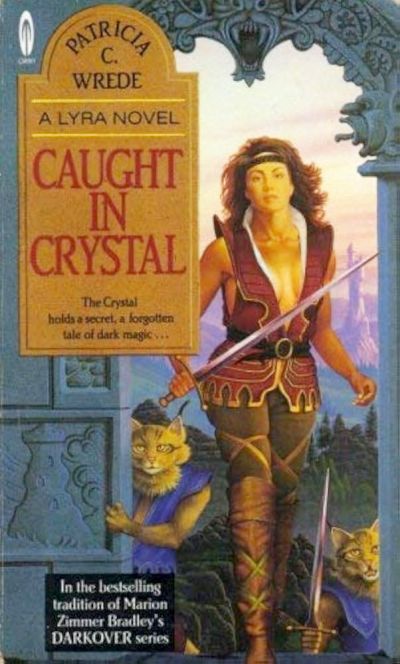 One of my favorite fantasy authors, Patricia C. Wrede [pronounced as “Reedy”] began her writing career in the late 70s; this book, published in 1987, is part of one of her earliest bodies of work, the five-novel Lyra series. However, it’s essentially a stand-alone; though all five of the books are set in the author’s fantasy world of Lyra, they’re all about entirely different sets of characters, widely separated geographically or chronologically (or both –like Tolkien’s Middle Earth, Lyra has a very long fictional history), and are unrelated in their plots.
One of my favorite fantasy authors, Patricia C. Wrede [pronounced as “Reedy”] began her writing career in the late 70s; this book, published in 1987, is part of one of her earliest bodies of work, the five-novel Lyra series. However, it’s essentially a stand-alone; though all five of the books are set in the author’s fantasy world of Lyra, they’re all about entirely different sets of characters, widely separated geographically or chronologically (or both –like Tolkien’s Middle Earth, Lyra has a very long fictional history), and are unrelated in their plots. However, there are definite flaws in Brandvold’s craftsmanship here, starting with chronology. John Bass served in the Mexican War, after which he married and settled in Kansas. The Bass family graveyard on the homestead is said to hold the remains of an infant sibling who died over 20 years before 1865 –in other words, before 1845, and the Bass twins would have been born ca. 1849. But the Mexican War was fought from 1846-1848. There isn’t time between Feb. 1848 and the end of 1849 to fit in John Bass’ post-war activity, subsequent courtship and marriage, the couple’s move to Kansas, and four pregnancies prior to Reno and Sara. (And Kansas was not even opened for settlement until 1854.) If his general knowledge of U.S. history didn’t furnish red flags here, very basic research would have precluded these kinds of mistakes.
However, there are definite flaws in Brandvold’s craftsmanship here, starting with chronology. John Bass served in the Mexican War, after which he married and settled in Kansas. The Bass family graveyard on the homestead is said to hold the remains of an infant sibling who died over 20 years before 1865 –in other words, before 1845, and the Bass twins would have been born ca. 1849. But the Mexican War was fought from 1846-1848. There isn’t time between Feb. 1848 and the end of 1849 to fit in John Bass’ post-war activity, subsequent courtship and marriage, the couple’s move to Kansas, and four pregnancies prior to Reno and Sara. (And Kansas was not even opened for settlement until 1854.) If his general knowledge of U.S. history didn’t furnish red flags here, very basic research would have precluded these kinds of mistakes.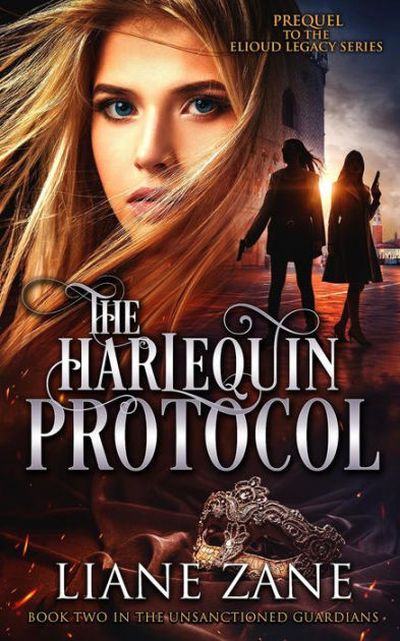 Because the author and I are Goodreads friends, she graciously gifted me with a review copy of the paperback edition of this book, as she has with all of her books, as soon as it was published; though she knew I’d really liked the previous book, she didn’t pressure me for a favorable review, but trusted that the book would stand on its merits. It definitely did; I actually liked this one even better! What earned the added appreciation (and the fifth star) was what I felt was the heightened dimension of moral challenge and choice here, which for me often makes the difference between great and merely good fiction, and which isn’t as strongly present in the first book. Discerning what the right thing is here requires thinking for oneself, not just obeying orders; and deciding to do it comes with a real risk, not just of harm to life and limb, but of disapproval from the powerful, of serious repercussions to one’s career, and maybe of legal punishment. The strong, distinct characterizations of the three heroines, who are each very different individuals though sharing a basic gut instinct for justice and decency, is also a positive feature that makes the book stand out from the pack.
Because the author and I are Goodreads friends, she graciously gifted me with a review copy of the paperback edition of this book, as she has with all of her books, as soon as it was published; though she knew I’d really liked the previous book, she didn’t pressure me for a favorable review, but trusted that the book would stand on its merits. It definitely did; I actually liked this one even better! What earned the added appreciation (and the fifth star) was what I felt was the heightened dimension of moral challenge and choice here, which for me often makes the difference between great and merely good fiction, and which isn’t as strongly present in the first book. Discerning what the right thing is here requires thinking for oneself, not just obeying orders; and deciding to do it comes with a real risk, not just of harm to life and limb, but of disapproval from the powerful, of serious repercussions to one’s career, and maybe of legal punishment. The strong, distinct characterizations of the three heroines, who are each very different individuals though sharing a basic gut instinct for justice and decency, is also a positive feature that makes the book stand out from the pack.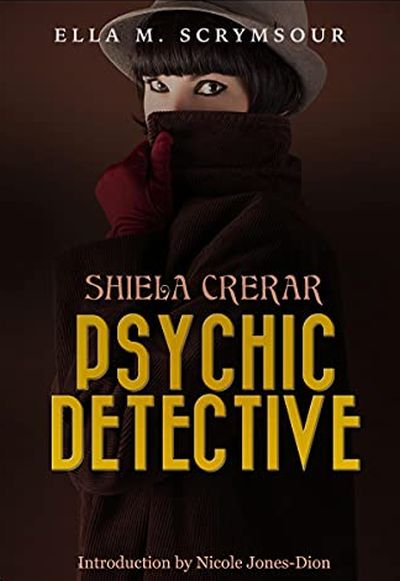 Orphaned as a child, Shiela Crerar was happily raised by an apparently bachelor uncle, a Highland laird with a lot of lineage but not a lot of money. The Sight ran in the family; both she and Uncle John were strongly psychic (her gift –or curse– as she’ll discover early on, allows her to see ghosts, something most people can’t), and she shared in his interest in and study of the paranormal. She’s a kind-hearted, frank and down-to-earth young woman who loves nature and likes to read; she’s also one with considerable determination and a strong will.
Orphaned as a child, Shiela Crerar was happily raised by an apparently bachelor uncle, a Highland laird with a lot of lineage but not a lot of money. The Sight ran in the family; both she and Uncle John were strongly psychic (her gift –or curse– as she’ll discover early on, allows her to see ghosts, something most people can’t), and she shared in his interest in and study of the paranormal. She’s a kind-hearted, frank and down-to-earth young woman who loves nature and likes to read; she’s also one with considerable determination and a strong will. We begin en media res, on her first mission as a fledgling operative in a town on the Egyptian Sinai penninsula, where she’s supposed to provide scouting and lookout functions for a team tasked with taking out a terrorist. (But circumstances will cause her role to morph into something more demanding….) Well positioned flashbacks show us how, as a smart, physically fit and observant Tel Aviv Univ. student with a double major in economics and foreign languages, a solid background of martial arts training, and no close family (her mother had recently died, and her brother had emigrated to the U.S.) she was recruited into Mossad. (Later flashbacks show her family’s harrowing trek to Israel from danger in an unraveling Ethiopia, on which her father was killed, when she was a very small child, and a later formative experience of standing up to two bullies in order to defend another child, which shaped her penchant for defending innocents.)
We begin en media res, on her first mission as a fledgling operative in a town on the Egyptian Sinai penninsula, where she’s supposed to provide scouting and lookout functions for a team tasked with taking out a terrorist. (But circumstances will cause her role to morph into something more demanding….) Well positioned flashbacks show us how, as a smart, physically fit and observant Tel Aviv Univ. student with a double major in economics and foreign languages, a solid background of martial arts training, and no close family (her mother had recently died, and her brother had emigrated to the U.S.) she was recruited into Mossad. (Later flashbacks show her family’s harrowing trek to Israel from danger in an unraveling Ethiopia, on which her father was killed, when she was a very small child, and a later formative experience of standing up to two bullies in order to defend another child, which shaped her penchant for defending innocents.)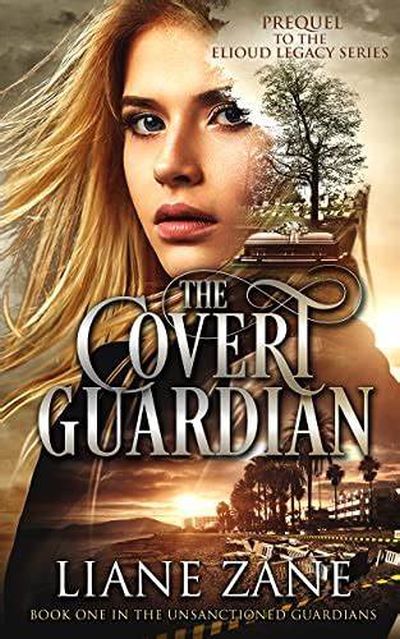 Liane Zane’s Elioud Legacy trilogy, all three books of which I’ve previously reviewed, is supernatural fiction, written by a Roman Catholic author, and premised on the fictional conceit that matings between angelic beings (both fallen and unfallen) and humans have been going on since before the Flood, producing mixed-race offspring who are physically human but have certain heightened physical or even latent supernatural abilities. That trilogy focused on three strong and courageous young women, who when it opened were completely unaware of their angelic genes, and all of whom were both serving in the intelligence services of their various countries, and collaborating with each other on the side in a covert alliance to provide some special protection for the victims of sexual assault and trafficking. The Covert Guardian is the first volume of a projected prequel trilogy, set a few years before the opening of the previously-published one, which will tell the “origin story” of their friendship and alliance. Here, our protagonist is Olivia Markham, the trio’s unofficial ringleader, and we learn how, as a 20-year-old college pre-med student, she unexpectedly came to join the CIA.
Unlike the first trilogy, this one really has no supernatural elements. Readers who’ve read the former will suspect, from certain subtle clues, that a couple of secondary characters here may also be Elioud, and will remember the St. Michael medal (a gift from her sensei) that Olivia wears, which feels strangely warm at times; and she has a sort of instinctive sixth sense for approaching danger that her then-boyfriend rather snidely dismisses as her “spidey sense.” But none of this is obviously paranormal nor impossible to explain naturalistically. I’ve classified the book as straight-out, descriptive action-adventure and espionage fiction, and it will definitely appeal to fans of those genres whether they have any liking for supernatural fiction or not.
The previously-published books mentioned, as a painful experience in Olivia’s past, the murder of her cousin Emily when the two girls were 16; they were close, and the tragedy was a formative factor in shaping Olivia’s deep desire to protect the innocent victims of brutality. In the modern U.S., the wheels of the justice system grind very slowly, so the killer’s trial was delayed until the summer before Olivia was to become a junior at Brown Univ. (She’s New England born and bred, living with her family in a suburban town outside Boston.) When our tale opens, soon after testifying, Olivia’s been talked by her boyfriend into joining him in a vacation on Ibiza, a real-life Mediterranean island off the coast of Spain which is a popular tourist destination, as a supposed opportunity to rest and heal from the re-lived traumatic experience. Even at this stage in her life, she’s strong, physically fit and athletic, smart, brave and quick-thinking; and since Emily’s murder, she’s been taking serious martial arts training. (And then there’s that “spidey sense” I mentioned….)
These qualities will stand her in good stead when, just four pages into the narrative, a squad of Islamist terrorists hit the beach, bent on slaughtering the revelers. Fortunately, a CIA counter-terrorist strike force is nearby; but by the time the action is over, Olivia’s displayed enough mettle to get their attention. (As they’ll soon learn, it also doesn’t hurt that she’s fluent in several languages, and qualified for the U.S. Olympic team in archery while still in high school.) Before the summer is over, she’s training at a CIA-run camp in North Carolina, and she feels that she’s found her true calling. And as luck would have it, an attractive female college student might just fit the mission profile for getting close to a wealthy young playboy type suspected of funding global terrorist activities. But chicanery, corruption, and betrayal of the U.S. aren’t necessarily things that only go on outside of the CIA, and our heroine’s path to joining the Company may not be an easy cake-walk.
Although the books of the Elioud Legacy trilogy are all thick, at just 155 pages, this one is more novella length, and a quick read. Like the former books, though, it moves around geographically, in this case to locations on three different continents; and the author’s knowledge of the physical geography of all of these settings is impressive. She’s a skilled wordsmith, seasoned in the novelist’s craft and able to immerse the reader in the story, and there are some surprises up her sleeve. For readers who want danger, tension, and well-depicted action scenes, this yarn definitely delivers. It’s not characterized by profound ethical dilemmas or deep spiritual, philosophical or political content, being more straightforward in those areas (in the context of the espionage genre, Zane is more in the tradition of Manning Coles or Alistair MacLean than, say, John LeCarre’), but I don’t view this as is any sense a fault, nor will most genre fans. What readers –genre fans or not– do want in fiction, more than action and danger, is the human element, a central character(s) we can like and feel invested in enough to care about the action and danger in the first place. That test is amply met here. Olivia is a winsome, dynamic protagonist whom we get to know and appreciate, and this is a character-driven tale of her growth and maturation in various ways in the crucible of a testing ordeal.
As I’ve said before in reviewing this author’s work, it’s fiction written by a Christian, rather than the kind of commercially “Christian fiction” the book trade markets as such. Olivia’s a basically kind and ethical-minded person, and cares about right and wrong as she understands them; but by her own statement, here she’s still “not really a believer.” Bad language is a hair more prominent here than in the first trilogy, though it’s actually more prominent in the first few pages here than it is in most of the book. College-age Olivia herself is capable, when she’s angry, of thinking or saying some pretty bad words, including obscenity (in a couple of languages). And though there’s no explicit sex, we know that an unmarried sexual encounter takes place at one point. The author makes us completely understand the psychology behind it; it’s a case of allowing the character to be who she realistically is, and possibly to grow through all of her decisions, both the good and the misguided ones, into the person she’s finally becoming. (That’s what good authors do.)
Finally, a worthwhile question might be, does a reader need to have read the Elioud Lagacy books before reading this one? My answer would be no; having read those books will allow you to better appreciate some adumbrations of the future you can see here, but it’s not essential, and no knowledge of them is presupposed here. You could begin with this book as an appetizer for the corpus as a whole.
Author: Liane Zane
Publisher: Zephon Romance; available
Liane Zane’s Elioud Legacy trilogy, all three books of which I’ve previously reviewed, is supernatural fiction, written by a Roman Catholic author, and premised on the fictional conceit that matings between angelic beings (both fallen and unfallen) and humans have been going on since before the Flood, producing mixed-race offspring who are physically human but have certain heightened physical or even latent supernatural abilities. That trilogy focused on three strong and courageous young women, who when it opened were completely unaware of their angelic genes, and all of whom were both serving in the intelligence services of their various countries, and collaborating with each other on the side in a covert alliance to provide some special protection for the victims of sexual assault and trafficking. The Covert Guardian is the first volume of a projected prequel trilogy, set a few years before the opening of the previously-published one, which will tell the “origin story” of their friendship and alliance. Here, our protagonist is Olivia Markham, the trio’s unofficial ringleader, and we learn how, as a 20-year-old college pre-med student, she unexpectedly came to join the CIA.
Unlike the first trilogy, this one really has no supernatural elements. Readers who’ve read the former will suspect, from certain subtle clues, that a couple of secondary characters here may also be Elioud, and will remember the St. Michael medal (a gift from her sensei) that Olivia wears, which feels strangely warm at times; and she has a sort of instinctive sixth sense for approaching danger that her then-boyfriend rather snidely dismisses as her “spidey sense.” But none of this is obviously paranormal nor impossible to explain naturalistically. I’ve classified the book as straight-out, descriptive action-adventure and espionage fiction, and it will definitely appeal to fans of those genres whether they have any liking for supernatural fiction or not.
The previously-published books mentioned, as a painful experience in Olivia’s past, the murder of her cousin Emily when the two girls were 16; they were close, and the tragedy was a formative factor in shaping Olivia’s deep desire to protect the innocent victims of brutality. In the modern U.S., the wheels of the justice system grind very slowly, so the killer’s trial was delayed until the summer before Olivia was to become a junior at Brown Univ. (She’s New England born and bred, living with her family in a suburban town outside Boston.) When our tale opens, soon after testifying, Olivia’s been talked by her boyfriend into joining him in a vacation on Ibiza, a real-life Mediterranean island off the coast of Spain which is a popular tourist destination, as a supposed opportunity to rest and heal from the re-lived traumatic experience. Even at this stage in her life, she’s strong, physically fit and athletic, smart, brave and quick-thinking; and since Emily’s murder, she’s been taking serious martial arts training. (And then there’s that “spidey sense” I mentioned….)
These qualities will stand her in good stead when, just four pages into the narrative, a squad of Islamist terrorists hit the beach, bent on slaughtering the revelers. Fortunately, a CIA counter-terrorist strike force is nearby; but by the time the action is over, Olivia’s displayed enough mettle to get their attention. (As they’ll soon learn, it also doesn’t hurt that she’s fluent in several languages, and qualified for the U.S. Olympic team in archery while still in high school.) Before the summer is over, she’s training at a CIA-run camp in North Carolina, and she feels that she’s found her true calling. And as luck would have it, an attractive female college student might just fit the mission profile for getting close to a wealthy young playboy type suspected of funding global terrorist activities. But chicanery, corruption, and betrayal of the U.S. aren’t necessarily things that only go on outside of the CIA, and our heroine’s path to joining the Company may not be an easy cake-walk.
Although the books of the Elioud Legacy trilogy are all thick, at just 155 pages, this one is more novella length, and a quick read. Like the former books, though, it moves around geographically, in this case to locations on three different continents; and the author’s knowledge of the physical geography of all of these settings is impressive. She’s a skilled wordsmith, seasoned in the novelist’s craft and able to immerse the reader in the story, and there are some surprises up her sleeve. For readers who want danger, tension, and well-depicted action scenes, this yarn definitely delivers. It’s not characterized by profound ethical dilemmas or deep spiritual, philosophical or political content, being more straightforward in those areas (in the context of the espionage genre, Zane is more in the tradition of Manning Coles or Alistair MacLean than, say, John LeCarre’), but I don’t view this as is any sense a fault, nor will most genre fans. What readers –genre fans or not– do want in fiction, more than action and danger, is the human element, a central character(s) we can like and feel invested in enough to care about the action and danger in the first place. That test is amply met here. Olivia is a winsome, dynamic protagonist whom we get to know and appreciate, and this is a character-driven tale of her growth and maturation in various ways in the crucible of a testing ordeal.
As I’ve said before in reviewing this author’s work, it’s fiction written by a Christian, rather than the kind of commercially “Christian fiction” the book trade markets as such. Olivia’s a basically kind and ethical-minded person, and cares about right and wrong as she understands them; but by her own statement, here she’s still “not really a believer.” Bad language is a hair more prominent here than in the first trilogy, though it’s actually more prominent in the first few pages here than it is in most of the book. College-age Olivia herself is capable, when she’s angry, of thinking or saying some pretty bad words, including obscenity (in a couple of languages). And though there’s no explicit sex, we know that an unmarried sexual encounter takes place at one point. The author makes us completely understand the psychology behind it; it’s a case of allowing the character to be who she realistically is, and possibly to grow through all of her decisions, both the good and the misguided ones, into the person she’s finally becoming. (That’s what good authors do.)
Finally, a worthwhile question might be, does a reader need to have read the Elioud Lagacy books before reading this one? My answer would be no; having read those books will allow you to better appreciate some adumbrations of the future you can see here, but it’s not essential, and no knowledge of them is presupposed here. You could begin with this book as an appetizer for the corpus as a whole.
Author: Liane Zane
Publisher: Zephon Romance; available